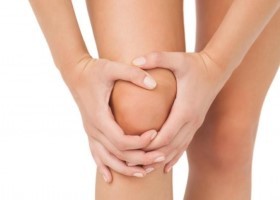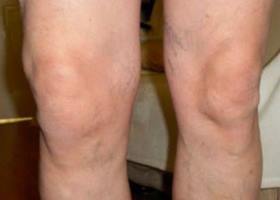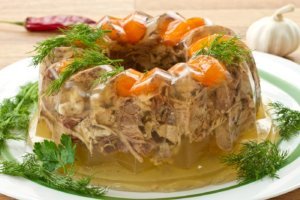
Arthrosis of the knee joint, also known as gonarthrosis, can significantly impair a person's quality of life. During the development of the disease, the hyaline cartilage in the joint gradually decreases. Cartilage gradually loses its density and height. Razvlecheniya and thinning is noticeable and over time completely disappears. Accordingly, there is no soft protective insert in the bone, and this leads to an increased load on the end plate of the innervated joint surface of the bone. As a result of this load, painful feelings develop. The code for osteoarthritis of the knee joint according to ICD-10 is M17.
The knee joint is affected quite often, as the knee puts a significant strain on walking, physical exertion, and running. In this case, awkward movements can lead to damage to the soft tissues of the knee and cause osteoarthritis. Therefore, gonarthrosis is a major cause of disability. According to statistics, this disease affects about 20% of the people on the planet to varying degrees.
Why does arthrosis develop, how can this disease be prevented, which doctor treats knee arthrosis, and what treatment methods can the doctor recommend after the diagnosis is made?
Pathogenesis
The disease develops in the background of the difference between the load on the joint and the resilience. In this case, the properties of the cartilage may be determined by genetics or may also change due to the effect of acquired factors - exogenous and endogenous. The development and progression of gonarthrosis with advancing age may be due to dysplasia of the femoral patellar joint or changes in the axis of the lower limb, abnormalities in the biomechanics of the joint, and damage to the meniscus and ligaments.
The pathogenesis is based on the predominance of catabolic material over anabolic processes observed in cartilage and subchondral bones, meniscus, and synovium. As a result, structural changes occur and the biological properties of the cartilage are lost. The pathological process extends further to the muscles and ligaments.
Joint cartilage is based on connective tissue matrix and chondrocytes. The connective tissue matrix contains type II collagen and aggrecan molecules. The damping properties of cartilage are precisely provided by the connective tissue matrix.
The inflammatory process of arthrosis is not as intense as in arthritis. However, anti-inflammatory mediators are also present in osteoarthritis.
Classification
According to the origin of gonarthrosis, we distinguish the following types:
- Primary (idiopathic)- develops without the influence of external causes.
- Secondary- certain factors lead to the development of the disease. They are most commonly associated with injuries, fractures, joint surgery, and inflammatory factors such as acute and chronic arthritis.
The following stages of knee arthrosis are also defined:
- Grade I arthritis- from the onset of the first signs of the disease to the development of bone deformities on the X-ray or during the period found during the examination. During this period, pain of varying intensity appears during movement.
- Grade 2- unpleasant sensations can be observed even at the slightest load. While walking and squatting, the knee crunches and joint mobility decreases. The picture shows the growth of bone tissue along the edge of the joint as well as the narrowing of the joint space. An external examination showed that the knee size had increased.
- Grade 3has virtually no cartilage in the joint. As the disease progresses, the bones can grow together, causing complete immobility of the foot. Sleep becomes disturbed without movement, sticks or crutches.
The following types of disease are also distinguished:
- Patellofemoral arthrosis of the knee- a condition in which degenerative changes are observed in the back of the patella, i. e. the patella. With this form of the disease, the pain is primarily disturbed by descent from a ladder downhill or from a mountain. Patellofemoral arthrosis can develop in runners. The disease is often diagnosed in young people.
- Post-traumatic arthrosis of the knee joint- a consequence of injury. Post-traumatic disease should not initially occur. But later, a person loses full motor activity in the joint.
Causes of knee arthrosis
The causes of such pathology are currently being studied.
Currently, the causes of gonarthrosis are related to the effects of the following factors:
- Age - at a certain age, degenerative changes in tissues begin in humans and the ability of cartilage tissue to regenerate decreases.
- Arthritis - Over time, arthritis can lead to arthrosis.
- Delayed injuries and overloads - in addition to injuries, the development of the disease can trigger the need for kneeling, squatting, weight lifting.
- Obesity and overweight - overweight increases the load on the joints of the legs. In addition, substances that cause damage enter the bloodstream from the abnormal adipose tissue and later into the joint.
- Inheritance - in some cases, the development of the disease is determined by a faulty gene responsible for the growth of cartilage tissue. As a result, this tissue may have low resistance to damage. If close relatives had osteoarthritis, this increases the likelihood of it.
- Diseases leading to metabolic disorders - the risk of this pathology is increased in atherosclerosis, diabetes mellitus.
- Hormonal disorders - women get sick more often after 55 years.
- Sports - People who play certain sports are more likely to develop the disease. This is typical of runners as well as football, tennis and basketball players.
Symptoms of knee arthrosis

As a general rule, the symptoms of knee arthrosis increase slowly as the process of developing it takes years. If multiple joints are involved, symptoms of polyarthrosis develop.
The manifestation of the disease depends on the severity, age and many other factors.
However, the main symptoms of gonarthrosis are:
- Pain in the knee joint aggravated by activity. While resting, your knees hurt less.
- Swelling in the knee area.
- Feeling warm in the joint.
- Unpleasant feelings of stiffness in the joint that occur when a person is in a static position for a long time.
- A decrease in the range of motion of the knee joint, making it difficult for a person to get out of a chair, go down stairs, or get out of a car.
- Crunching and cracking in the knee, most often with sudden joint movements.
- Changes in the weather are thought to affect the degree of pain and discomfort.
Analysis and diagnostics
To determine if such a disease is curable, the diagnosis must first be confirmed. During the diagnosis, the doctor examines and interviews the patient. But the most informative study in this case is an x-ray of the knee.
In addition, in order to clarify the diagnosis, it is advisable to perform an ultrasound examination, during which arthritis can be ruled out and the height of the articular cartilage can be measured.
If necessary, select additional studies.
Treatment of knee arthrosis
In order to treat this disease as effectively as possible, the diagnosis must first be confirmed and the correct regimen of complex therapy must be selected. Home treatment of knee arthrosis is possible if the patient carefully follows all the recommendations of the specialist, practicing both medication and additional treatments. Only in this case can home therapy be effective.
Medication and other therapies for this disease are used depending on the degree of damage. The easiest way to treat grade I knee arthrosis. In the case of first-degree disease, a complex therapeutic system is used, which allows it to achieve the effect in the shortest possible time. Therefore, if a person is diagnosed with grade 1 osteoarthritis, the disease should be treated immediately.
The treatment of grade 2 arthrosis of the knee joint is decided by the doctor based on the patient's condition. Because changes in cartilage tissue begin at this stage, treatment should be performed immediately.
Whether it is possible to cure grade 3 knee arthrosis depends on many factors. In grade 3, the cartilage becomes thinner, so the treatment at this stage is lengthy and least effective.
Medications
Medical treatment of knee arthrosis aims to provide analgesic and anti-inflammatory effects. It is also important to reduce the severity of cartilage destruction.
The following medications are used for this purpose:
- Non-steroidal anti-inflammatory drugs - ointments and gels are used in both tablets and topical treatments. The most effective local and systemic application of such funds.
- Chondroprotectors for knee arthrosis - chondroprotectors from the group of glycosaminoglycans (hyaluronic acid), chondroitin sulfates and others. Such drugs are prescribed for osteoarthritis of the knee as part of a comprehensive treatment. The price of chondroprotectors depends on the drug and varies significantly.
- In severe disease, the drug also contains steroids. Injections of knee arthrosis can be administered intramuscularly, and external agents with steroids can also be used.
- Skin irritants. You may also find annoying compressions in the description of folk remedies.
- During treatment, your doctor may prescribe injections into your knee. Various medications can be used for knee joint injections for arthrosis. In particular, corticosteroids are injected to relieve severe inflammation. A review of injections indicates that steroids work in this form the fastest and most effectively. Knee blockade can be performed not only with glucocorticosteroids but also with anesthetics. A review of the blockade indicates that this method is effective in relieving even severe pain. Injection into the knee during treatment with chondroprotectors. Improves metabolic processes, activates collagen production. But at least five injections must be given to achieve the effect. Hyaluronic acid is injected intraarticularly, which improves the quality of the intraarticular fluid and provides effective protection for cartilage tissue. Vitamins can also be administered intra-articularly.
- Plasmolifting method - the essence is the introduction of platelet-rich blood plasma into the sore knee.
- Medical bile in arthrosis of the knee joint - used for compresses. It should be noted that medical bile can only be an effective treatment if its use is prescribed by a doctor according to a certain scheme. Therefore, in this case, the possibility of "treating at home" without consulting a doctor is unacceptable.
Procedures and operations
In the case of arthrosis and polyarthrosis, non-pharmacological treatments are also used, the use of which is no less effective.
Physiotherapy. Various techniques are used, including shock wave therapy, myostimulation, phonophoresis, ozone therapy, kinesitherapy, and other methods. Physiotherapy can reduce pain, relieve inflammation. The physiotherapy prescribed by the doctor should be performed in exactly the complex that the doctor advises.
Laser therapy- has a decongestant, analgesic, anti-inflammatory effect.
Ozone therapy- relieves pain, has an anti-inflammatory effect, which allows you to reduce the amount of hormonal drugs used.
Knee pads for knee arthrosis- Wearing such devices reduces the severity of the pain. In addition, the knee brace protects against instability. But to achieve the desired effect, you need to choose the right knee pads or knee brace. There are several general tips on how to choose a knee pad in arthrosis of the knee joint. In addition, they offer many of these knee pads - with restraints, amps and the like. But still, those who want to buy a knee pad for arthrosis should not rely on user reviews but on a doctor’s recommendation. The price of an orthopedic knee pad depends on various characteristics - material, quality. Knee pads are especially relevant if the patient develops post-traumatic arthrosis. But patellofemoral arthrosis as well as other types of disease can also be treated with this method.
therapeutic exercise for knee arthritisis an effective method to improve the condition and prevent surgery, provided that the person practices regular and persistent knee arthrosis. Physiotherapy exercises help to strengthen the muscles of the legs and stop the development of the pathological process. However, a series of exercises for arthrosis of the knee joint should be performed in a certain order, and such exercises are selected individually. Therefore, it is best if the lessons are not based on a gymnastics video but on a series of exercises developed by a doctor. In this case, not only the charge is important, but the whole workout.
Different types of movement therapy can be practiced with similar pathology.
Special tournament.Such exercises are recommended for prevention both during treatment and for people over 40 years of age. Knee exercises should be done every day. These exercises are also suitable for older adults as they can be done at a leisurely pace.
Massage and manual therapy- suitable for patients with reduced mobility, can be combined with exercise. In the absence of the possibility to visit a massage therapist, self-massage can be performed according to the scheme presented by the specialist.
Additional methods for improving the patient's condition and active rehabilitation include yoga, acupuncture, joint stretching, exercises on special simulators (exercise bike and others).
If conservative methods prove ineffective, surgical treatment is used.
The following techniques can be used:
- Puncture- The release of excess fluid in the joint can reduce the symptoms of inflammation and restore mobility.
- Arthroscopy- can be performed using endoscopy. With this technique, joint surfaces are cleaned of fragments of destroyed cartilage tissue.
- Periarticular osteotomy- this procedure saws and fixes one of the bones that make up the knee joint at a different angle. As a result, the severity of the pain decreases and the mobility of the knee increases. The intervention is effective in the first and second stages of the disease.
- Endoprosthetics- replacement of the knee joint with a special biocompatible construction. This is a very complex intervention that is performed with the third stage of the disease.
Treatment of knee arthrosis with folk remedies
Numerous reviews of the treatment of folk remedies for the disease confirm that such methods can be used as adjuncts, facilitating the patient's condition. However, such methods cannot replace the main treatment. Folk remedies are used for rubbing, compressing, bathing, swallowing. Any thematic forum contains a lot of advice on this issue.
- Rubbing with garlic. Several cloves of garlic should be peeled and chopped. Mix the resulting fat with 200 ml of vegetable oil and stick in a dark place for a week. Put it on your knees overnight with a film and a warm cloth on top.
- Mustard flour. To prepare the cure, take 50 g of camphor and mustard powder, 500 ml of vodka, one egg white. Mix each and store in a bottle in a dark place for a week. The product should then be rubbed into the knee three times a day.
- Elecampane Grind. Pour 50 g of elecampane root into 125 ml of vodka and leave for two weeks. Rub twice a day.
- Compresses the burdock. Burdock is a popular folk remedy for the treatment of arthrosis. On the burdock, several sheets should be folded down with the side of the bug and smeared with vegetable oil. Attach them to your knees and cover them with cellophane and a warm cloth on top. Burdock leaves can also be greased with vodka. The compress is applied at night. Similarly, horseradish leaf treatment is also performed.
- Cabbage leaf. It is also applied to the sore spot at night. Pre-lubricate with honey, cologne or vodka.
- Honey compress. Mix honey, ammonia (10%), glycerin and medicinal bile in equal parts, add a few drops of iodine. Leave the premixed product in a dark place for 10 days. Warm up before warming the compress.
- Onion decoction. They are taken internally. To make the broth, take two large onions, chop and pour 1 liter of water. Cook until the onions are soft. Take a 100 ml decoction three times a day.
- Celery juice. Grind the celery stalks in a blender, squeezing the juice. Drink 100 ml of juice three times a day.
- Gelatin. In case of arthrosis, it is recommended to eat foods that contain gelatin. It is recommended to add jelly, jelly and other gelatinous dishes to the menu.
- Bath needle bath. Pour hot water on 1 kg of pine needles and leave for a few hours. Fill into a warm bath in which 0. 5 kg of salt can be dissolved. Bathe for 20-30 minutes.
Prevention
The following preventive measures should be taken to prevent the development of knee arthrosis:
- Eat correctly and include foods containing various vitamins and minerals in your diet.
- Avoid overloading the knee joint and protect it from injury.
- Quit bad habits.
- Monitor your weight, prevent obesity.
- Treat all diseases in a timely manner, perform preventive examinations.
- Exercise with gentle physical activity.
- Wear high-quality shoes that are as comfortable as possible.
- Ensure proper posture.
Diet for Arthrosis of the Knee Joints

- Efficacy: therapeutic effect
- Terms: permanently
Diet is very important during treatment and rehabilitation. First, the food should be healthy and light - it is important to prevent the growth of excess weight, which can aggravate the condition and trigger acute arthrosis. But the acute course of the disease requires not only treatment but also weight loss.
It is important to include in your diet foods that contain important ingredients for cartilage:
- Poultry, rabbit.
- Sea fish.
- Soy products.
- Eggs.
- Greens, zucchini, carrots, pumpkin.
- Nuts.
- Fruits, berries.
- Vegetable oils.
- Foods with gelatin.
However, you should limit your consumption of such products:
- Beans, sorrel, spinach, tomatoes.
- Flour pots.
- Animal fat.
- Spices, vinegar.
- Alcohol.
- Red meat
Eat often, in small portions. You should also drink about 2 liters of fluid a day.
Consequences and complications
If treatment is not performed on time, arthrosis can lead to the following complications:
- Inflammatory process of periarticular tissues.
- Restriction of joint mobility.
- Changing the shape of joints.
- Degeneration of the hip joint.
Such complications can lead to disability and irreversible changes.
Forecast
Timely treatment of the disease is important. The best prognosis will be if you start treatment at stage 1 or 2 of the disease.



































